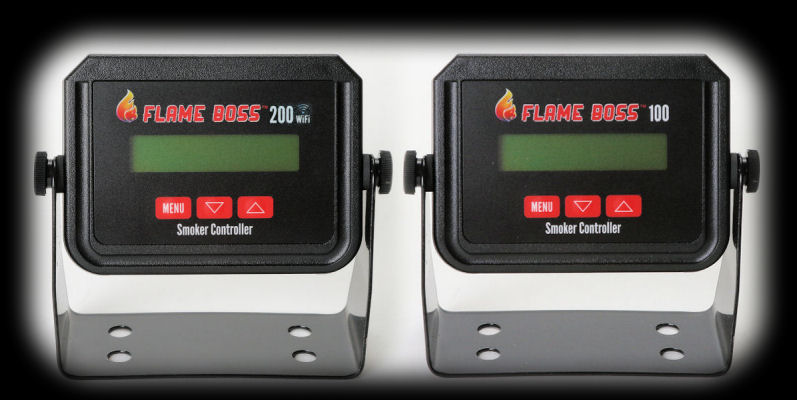 |
 |

All the connections are on the bottom edge of the system unit. The following photo shows (from left to right) the power plug, the blower plug, the pit temperature probe plug and the meat temperature probe plug:
The Flame Boss controllers come with two temperature probes, one for the pit and one for the meat. Unlike most controllers, these probes are not thermocouples. They are platinum RTD sensors. What's that? Well, if you don't want to know skip the next 3 paragraphs. First of all, a thermocouple works on the Seebeck effect. When two ends of a conductor (wire) are at different temperatures, a voltage is created between the two ends. The magnitude of the voltage depends on the temperature difference between the two ends. If you take two conductors made from different materials, there will be a different voltage created in each conductor. Then if you connect the two conductors at one end, the two voltages will add producing a voltage across the two conductors that varies with temperature. With me? If you know the materials, then you know the voltage generated for each temperature and this then gives you the DIFFERENCE in temperature between the two ends of the pair of conductors. Finally, you put a thermistor inside the meter that the probe plugs into to tell you the temperature of that end of the pair of conductors. Voila! You know the temperature of one end of the pair of wires, and you know the temperature difference between the two ends. Therefore you know the temperature of the other end! Simple, eh?Still with us? Good. One note of warning before we proceed. The plugs used on these probes are the same as the plugs used on probes made by at least one other manufacturer of temperature controllers. Thermocouples and RTD probes are not plug compatible, so just because the plug looks the same, don't be tempted to use the probes from another manufacturer. So here are photos of the temperature probes:
The probes are made from stainless steel and as we just explained contain a platinum RTD sensor. The cables have stainless steel armor braid that is coated with PTFE and can withstand temperatures up to 500°. What is PTFE? Well, scientists know it as Polytetrafluoroethylene. We mere mortals know it as Teflon®. Be careful not to kink the wire. The junction where the cables enter the probes appears not to be sealed, so avoid getting this junction wet. The probe and the wire should be shielded from direct radiation from a hot fire. Do not let it come into direct contact with flames. If you need to shield the wire, you can place a layer of aluminum foil beneath it. Also, having the pit probe itself exposed to direct radiant heat can cause it to register a temperature which is higher than the air temperature in the cooker, and thus fool the controller into cutting back on the fire. (If a probe does fail, you will be able to tell because when plugged into the controller with no heat applied to the probe, the controller display will show three dashes instead of a numeric value.) An alligator clip is provided with the pit probe which you can use to clip the probe to your dome thermometer or the food grid, as you see fit. How accurate are the probes? We measured the temperature of boiling water using the Flame Boss controllers. Using our boiling point calculator to determine the boiling point of water, the Flame boss controllers got the measurement within 1 to 2 degrees. As we previously explained, RTD sensors require no calibration, so there is no calibration procedure. Now let's take a look at the blower. Here are photos of the blower and the adapter:
The Flame Boss blower is rated at 6.5 CFM which is definitely adequate for most home-sized cookers. It has no built in damper. Also, the connection between the blower and the adapter is not airtight. The blower is merely inserted into the hole in the adapter and a tab on the blower housing keeps the blower from falling out of the adapter. Together these two factors allow a lot of air to enter the cooker even when the blower is not activated. It also makes the blower susceptible to wind forcing more air into the cooker. We'll see later how this affects the unit's ability to control the temperature of the cooker at low temperatures.
One last note about the blower. The Flame Boss units are plug-compatible with BBQ Guru blowers. If you have a BBQ Guru controller and wish to move to a Flame Boss (say, for example to upgrade from a non-wifi unit to the Flame Boss 200 Wifi unit) you can buy a Flame Boss system unit by itself and use the BBQ Guru blower instead of purchasing the Flame Boss blower. Also if you find you want an upgrade over the Flame Boss blower after you purchase your unit, you could buy a BBQ Guru blower to replace it.
|
You can support this website by shopping at The Naked Whiz Website Store and Amazon.com
|